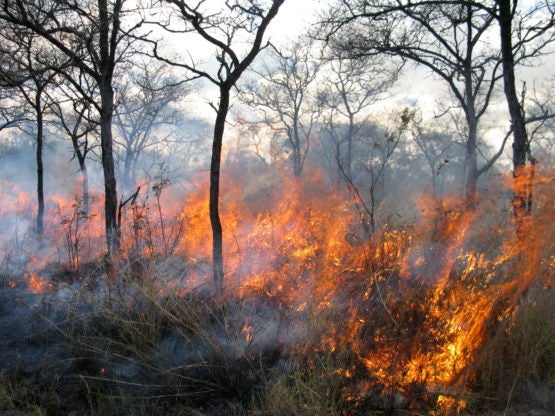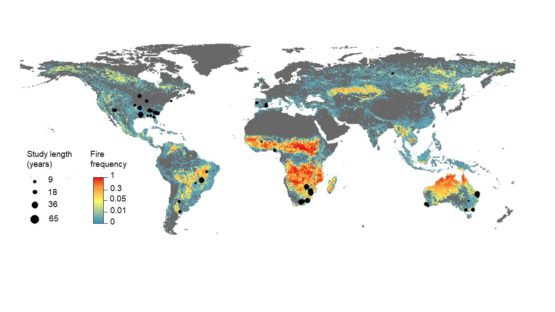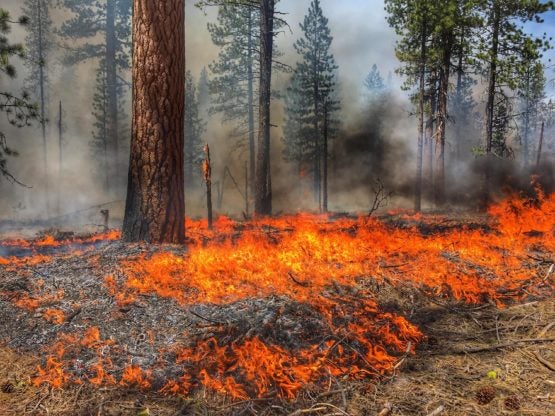More frequent fires reduce soil carbon and fertility, slowing the regrowth of plants
Long-term effects of repeated fires on soils found to have significant impacts on carbon storage not previously considered in global greenhouse gas estimates.
Frequent burning over decades reduces the amount of carbon and nitrogen stored in soils of savanna grasslands and broadleaf forests, in part because reduced plant growth means less carbon being drawn out of the atmosphere and stored in plant matter. These findings by a Stanford-led team are important for worldwide understanding of fire impacts on the carbon cycle and for modeling the future of global carbon and climate change.
The results, published Dec. 11 in the journal Nature, offer a new perspective on the impact of fire on soil fertility.

Repeated fires in savannas, which are dominated by grasses, can reduce carbon and nitrogen in soils for decades. The reduction in nutrients can lead to poor plant regrowth. (Image credit: Carla Staver)
“Almost all the synthesis studies done to date conclude that fire has relatively little effect on soils, but in large part, researchers focused on a single fire event,” said Adam Pellegrini, a post-doctoral scholar at Stanford’s School of Earth, Energy & Environmental Sciences and lead author on the study.
Instead, this study examined soil carbon and fertility in different ecosystems over 65 years.
“We are interested in the ways ecosystems change over many decades,” said Rob Jackson, professor of Earth System Science and senior author on the study. “As the Earth’s climate warms, we need to understand how changing fire frequencies alter soils and plant growth.”
Together with an interdisciplinary team of researchers from eight institutions across the world, Pellegrini and Jackson found that estimates of fire impacts on the ecosystem’s ability to store carbon may be substantially off. The new findings could help land managers better weigh how often they use prescribed burns to manage grasslands and forests.
Fire and ecosystems
Focusing on three different types of landscapes – savanna grasslands, broadleaf forests, and needleleaf forests – from 48 sites covering multiple continents, the researchers compiled records of soil fertility after fires over up to 65 years. Comparing the changes in soil nutrients over time, they found that in frequently burned areas in savannas and broadleaf forests, there was a 36 percent reduction in soil carbon and a 38 percent reduction in nitrogen compared to areas that were protected from fire. Conifer forests did not show this reduction in soil carbon and nitrogen after fires.

The locations of the fire-soil data used in the study, shown in black dots, on top a map showing the frequency of fires around the world. (Image credit: Adam Pellegrini)
“You can imagine after only one year, fire wouldn’t make much of a difference, but over multiple years and repeated burning, the lack of plant inputs into soils decreases carbon and nutrients,” said Pellegrini. “Plant productivity is what draws carbon out of the atmosphere – that’s what sequesters the carbon. What we see over time is not just a net increase in the carbon emissions to the atmosphere, but a net decrease in carbon sequestration.”
After the team found that repeated fire causes the continued loss of carbon and nitrogen in savannas and broadleaf forests, they wanted to see how plant recovery might be affected. They used a vegetation model to predict global plant growth in frequently burned areas and found the loss of nitrogen in soils suppressed the regrowth of plants.
Reduced carbon storage
The slower plant growth has implications for carbon storage, and Jackson warned there’s a long-term feedback that should be considered. “There are additional losses and changes in carbon that can happen decades later because plants are unable to grow back as quickly as they would have,” said Jackson, who is also a senior fellow at the Woods Institute for the Environment.

Fire in a conifer-dominated forest may not burn through the thick layer of needles on the forest floor, essentially protecting the soil below. (Image credit: Adam Pellegrini)
Surprisingly, needleleaf forests didn’t show the same loss of nutrients. Instead, the conifer-dominated forest soils actually had more carbon and nitrogen present with frequent burning. Pellegrini explained that burning of the dense layer of partially decomposed pine needles on the forest floor might provide ash to the soils, and added that future work will further examine the effects of fire in this type of forest.
The researchers stressed that they are not advocating fire suppression. “Fires often increase the diversity of plants and reduce the risk that a landscape will have a high-intensity fire,” said Pellegrini.
Instead, in a time where climate change creates drier and warmer conditions that favor fire, fire managers and conservationists may have to shift their management strategies.
“Managers may need to take a longer view of how much and how often they choose to burn systems,” said Jackson.
Adam Pellegrini is also a NOAA Climate and Global Change Postdoctoral Fellow. Rob Jackson is also a senior fellow at the Precourt Institute for Energy. Additional Stanford co-authors include postdoctoral scholar Anders Ahlström. The paper also includes authors from Lund University, University of Minnesota, Western Sydney University, Yale University, University of Wisconsin–Stevens Point, Kansas State University, and the University of Utah, University of California, Irvine.
The study was funded by the National Oceanic and Atmospheric Administration, the Gordon and Betty Moore Foundation and the Department of Energy.
